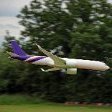-
Posts
10,347 -
Joined
-
Last visited
-
Days Won
18
Simon Chaddock last won the day on May 13 2023
Simon Chaddock had the most liked content!
Recent Profile Visitors
4,441 profile views
Simon Chaddock's Achievements
1.2k
Reputation
-
Terry If you really want to use the components you listed then designing something to suite is not as daft as it sounds. The chances of finding a plan for a plane that suites your bits is going to make things rather harder. The normal process is to identify a plan for a plane that you like and then assemble the appropriate bits identified on the plan. You have not said whether you already fly an RC plane. If you do it might help if you could tell us what it is. If you are completely new to the hobby then regardless of the plane you end up with you will need a transmitter and receiver. It is likely to be the most expensive item so the choice does need some care. To make matters worse the options are as big as how much you are willing to spend! You can start to see why a complete ready to fly (RTF)plane that includes everything, is a practical way of getting started. All the choices, good or bad, have been made for you and you know it can fly with that combination of bits. Whether you will be able to fly it is another issue. Have you considered joining a model flying club as a way to get to learn to fly? They may well have a club trainer and instructor.
-
Terry Not a recommendation as such but it might give you an idea of the size of glider? you will likely end up with. In this case a ready made foam 'toy' chuck glider converted to a powered tractor. 1.2m (47") span. A 10A ESC, 6x3 folding prop, 2804 1800kV motor, 850mAh 3s. It weighs 320g (11.25 oz) ready to go. Will fly for 20 minutes under reduced power and glides very nicely too.
-
Is their not a fundamental difference in what here has been termed A3X and SAFE? With A3x the gyros react to a disturbance of the plane. It does not override the control inputs. The rate and expo settings in the TX have no influence on how the gyro reacts. The gyro may continue to operate even when the TX is switched off. My Lemon "stab" receivers certainly do! SAFE limits the effect of control inputs on the plane. It thus overrides the control inputs but only when the planes set attitude limits have been reached. As stated the expo and rates on the Tx will determine how quickly those control inputs will allow the planes limits to be reached. If the A3X function is still operating it will also independently limit how quickly the limits can be reached whether that is by stick input or external influence. It appears there is no standard for how a gyro system reacts so there will be differences between manufacturers or even individual models of gyro. My understanding based on my own experience. Of course I could be completely wrong.
-

Motion RC - Flightline - B24 - Liberator
Simon Chaddock replied to toto's topic in Build Blogs and Kit Reviews
toto That's quite an impressive plane. Uncovered servos in a foam depression are simple to do and if flush with the surface have no aerodynamic penalty. You could always use a bit of filler and paint to disguise them. Probably worth getting some matching "touch up" paint anyway once you get round to flying it. 😉 -
Basil I am not quite sure to what you are referring but are aware the LM0033 is only a "rate" stabilised receiver. As such it has no "auto" stabilisation feature so there is no setting up required for the plane to be in the correct attitude prior to switch on however like any gyro system you have to ensure its reaction any sudden deviation moves the controls in the correct sense to counter it. The stabilisation thus limits the rate at which the model deviates in roll, pitch and yaw when the deviation has not been commanded. The result is well trimmed flight is much smoother however recovery from any attitude to straight and level is entirely down to the pilot. I have several such "Stab" receivers. They certainly reduce the stress in a maiden flight, particularly if it is an "own" design.😉 I hope this helps
-
I would like to give a huge thank you to John and the other members of the DVMFC for a wonderful days flying. In my case some of my planes were a bit more successful that others. The Southerly wind and turbulence was a bit more than some of my lightweight can readily handle. However this was not the case on the first plane which was absolutely my own fault. I forgot to extend the aerial on the 35 meg TX. ☹️ Never mind they will all fix. Thanks again.
-
Toto Hope you fly OK Talking of packing planes into a car. Ready for my trip to the DVMFC tomorrow.
-

Motion RC - Flightline - B24 - Liberator
Simon Chaddock replied to toto's topic in Build Blogs and Kit Reviews
Toto With such a large and heavy plane I would not worry too much about the flight time. I think you will find 5 minutes will be plenty long enough to start with. If you haven't crashed within the first 2 minutes of a flight you probably won't but the longer the flight the chances of making an error rise. The critical part is always the circuit & landing. Compared to a flight duration it doesn't take that long but it is critical and needs to be mastered. Shorter flights will mean you keep within battery limitations and you get more landing practise. -

Advice on faulty goods
Simon Chaddock replied to Tim Kearsley's topic in R/C Retailers / Distributors / Manufacturers
Tim "Four of the same make Iron failed over four years" That tells me something about optimism. I hope the replacement last longer. -

Forum members' new models: Let's see them.
Simon Chaddock replied to Paul Marsh's topic in All Things Model Flying
Not exactly new but a Swiss Venom severely rebuilt. From this 9 days ago. To this as of today. Amazingly none of the electrics or even the battery in the nose needed replacing. -
toto An important part of building is working out the best way to get round any mistakes you have made. After all when the plane is all finished no one will see an extra joint or two that was not shown on the plan. 😉
-
Toto A properly located E clip in a sharp edged groove should be better than a collet as it provides 3 physical points to prevent the wheel sliding off the axle. A collet on the other hand basically relies on the grub screw generating friction between the axle and the collet. A collet would only match the restraining power of an E clip if its grub screw located into a matching conical indent on the axle.




